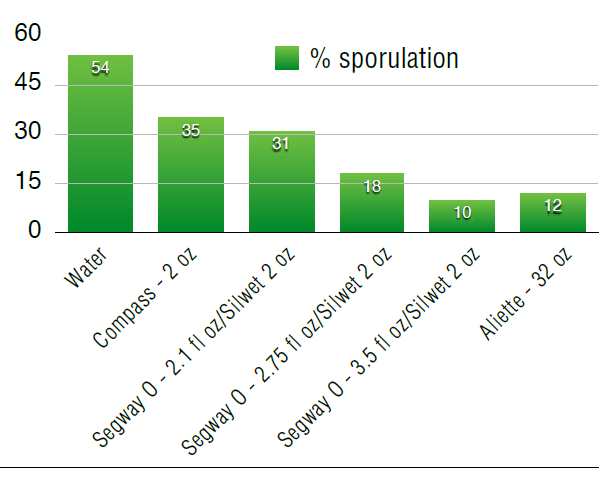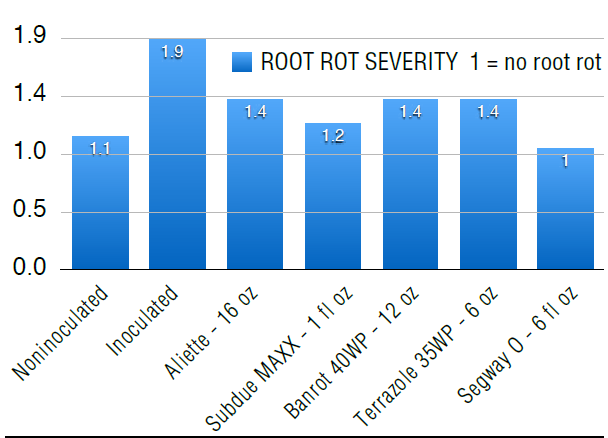Knowde Enhanced TDS
Identification & Functionality
- Chemical Family
- FRAC Code
- Agrochemical Functions
- Technologies
- Product Families
- Composition
ACTIVE INGREDIENT: Cyazofamid* 34.5% OTHER INGREDIENTS 65.5% TOTAL 100.0% *4-chloro-2-cyano-N,N-dimethyl-5-(4-methylphenyl)- 1H-imidazole-1-sulfonamide (CA) Contains 3.33 pounds Cyazofamid per gallon (400 grams per liter).
Features & Benefits
- Agrochemicals Features
- Product Highlights
Segway O should be utilized as a protectant fungicide and applied before the disease damages the crop. Depending on disease risk and severity, users may expect protection for a period of 7 to 28 days after treatment.
- Common Name: Cyazofamid
- Class: Cyano-imidazole
RESTRICTED ENTRY INTERVAL (REI) AND SIGNAL WORD
- REI = 12 hours
- Signal Word = CAUTION
- Key Diseases Controlled
- Pythium
- Phytophthora
- Downy Mildew
- Product Info
SEGWAY O is a flowable suspension concentrate for control of Pythium, Phytophthora and Downy mildew diseases on ornamental plants in landscapes and plants grown in commercial greenhouses and nurseries.
Applications & Uses
- Markets
- Applications
- Applicable Crop
- Application Technique
- Fungicide Target Species
- Mode Of Action
The mode of action of Segway O is complex III of fungal respiration: quinone inside inhibitor (QII), Qi site (Fungicide Resistance Action Committee code 21).
- Use Sites
Segway O may be used on ornamentals, bedding plants, herbs, tomatoes, and bell peppers grown in greenhouses and nursery situations.
- Application Rates
Foliar spray: Applications of fungicides should begin when conditions are favorable for disease development or when plants first exhibit disease symptoms, from germination to mature crop. Use another fungicide with a different mode of action between applications of Segway O.
Pythium crown and root rots and damping-off : 1.5 fl. oz. to 3.0 fl. oz. per 100 gallons 14 to 28 day interval. Phytophthora crown and root rots and foliar blights : 3.0 fl. oz. to 6.0 fl. oz. per 100 gallons 14 to 28 day interval. Downy mildews : 2.1 fl. oz. to 3.5 fl. oz. per 100 gallons 14 to 21 day interval. Container grown plants : Soil application (for control of Pythium and Phytophthora soil borne diseases) For drench application to containerized plants, use enough solution to wet the root zone with minimal leaching. In general one pint of solution/square foot is sufficient. Containers larger than 4-inch depth generally require from 1½ to 2 pints of the solution/square foot.
Field Grown (Bed) Plants
Use sufficient water solution to allow for penetration into the root zone. Apply Segway O fungicide at the rate of 6 fl. oz. per 100 gallons. Irrigate with ½ inch of water if rainfall does not occur within 24 hours. Do not make more than 2 applications per year.
- Tank Mixing
To determine the physical compatibility of Segway O with any other product, use a small container to mix a small amount of spray solution, containing all ingredients in the same order and ratio as the anticipated use. If any indication of physical incompatibility develops, do not use and discard. Indications of physical incompatibility usually appear within 5-15 minutes of mixing.
Rose downy mildew control

Phytophthora root rot prevention on Spathiphyllum

- Agricultural Use Requirements
Use this product only in accordance with its labeling and with the Worker Protection Standard, 40 CFR Part 170. This Standard contains requirements for the protection of agricultural workers on farms, forests, nurseries, and greenhouses and handlers of agricultural pesticides. It contains requirements for training, decontamination, notification, and emergency assistance. It also contains specific instructions and exceptions pertaining to the statements on this label about personal protective equipment (PPE), and restricted-entry interval. The requirements in this box only apply to uses of this product that are covered by the Worker Protection Standard. DO NOT enter or allow worker entry into treated areas during the restricted entry interval (REI) of twelve (12) hours.
PPE required for early entry to the treated areas that is permitted under the Worker Protection Standard and that involves contact with anything that has been treated, such as plants, soil, or water, is:
- coveralls,
- chemical resistant gloves made of any waterproof material,
- shoes plus socks and protective eyewear. Commercial greenhouses and nurseries are within the scope of the Worker Protection Standard.
- Non-Agricultural Use Requirements
The requirements in this box apply to uses of this product that are not within the scope of the Worker Protection Standard for agricultural pesticides, 40 CFR Part 170. The WPS applies when this product is used to produce agricultural plants on farms, forests, nurseries, or greenhouses. Ornamental landscapes are not within the scope of the Worker Protection Standard. Keep children, pets, and unprotected persons out of the treated area until sprays have dried.
- Resistance Management
Some plant pathogens are known to develop resistance to products used repeatedly for disease control. SEGWAY O’s mode/target site of action is complex III of fungal respiration: ubiquinone reductase, Qi site, FRAC code 21. A disease management program that includes alternation or tank mixes between SEGWAY O and other labeled fungicides that have a different mode of action and/or control pathogens not controlled by SEGWAY O is essential to prevent disease resistant pathogens populations from developing. SEGWAY O should not be utilized continuously nor tank mixed with fungicides that have shown to have developed fungal resistance to the target disease. For resistance management, SEGWAY O contains a Group 21 fungicide. Any fungal population may contain individuals naturally resistant to SEGWAY O and other Group 21 fungicides. A gradual or total loss of pest control may occur over time if these fungicides are used repeatedly in the same fields. Appropriate resistancemanagement strategies should be followed. To delay fungicide resistance, take one or more of the following steps:
- Rotate SEGWAY O or other Group 21 fungicides within a growing season with different groups that control the same pathogens.
- Use tank mixtures with fungicides from a different group that are equally effective on the target pest when such use is permitted. Use at least the minimum application rate as labeled by the manufacturer.
- Adopt an integrated disease management program for fungicide use that includes scouting, uses historical information related to pesticide use, and crop rotation, and which considers host plant resistance, impact of environmental conditions on disease development, disease thresholds, as well as cultural, biological and other chemical control practices.
- Where possible, make use of predictive disease models to effectively time fungicide applications. Note that using predictive models alone is not sufficient to manage resistance.
- Monitor treated fungal populations for resistance development.
- Contact your local extension specialist or certified crop advisor for any additional pesticide resistance-management and/or IPM recommendations for specific crops and pathogens.
Properties
- Formulation Type
Safety & Health
- Personal Protective Equipment (Ppe)
Applicators and other handlers must wear:
- Long-sleeved shirt
- Long pants
- Chemical-resistant gloves made of any waterproof material
- Shoes plus socks
Remove PPE immediately after handling this product. Wash the outside of gloves before removing. As soon as possible, wash thoroughly and change into clean clothing. DO NOT allow contact of contaminated clothing with unprotected skin. Follow manufacturer’s instructions for cleaning/maintaining PPE. If no such instructions for washables, use detergent and hot water. Keep and wash PPE separately from other laundry.
- Precautionary Statements
HAZARDS TO HUMANS AND DOMESTIC ANIMALS
CAUTION Harmful if absorbed through skin. Avoid contact with skin, eyes or clothing.
- User Safety Recommendations
- Wash thoroughly with soap and water after handling and before eating, drinking, chewing gum, using tobacco or using the toilet.
- Remove clothing/PPE immediately if pesticide gets inside. Then wash thoroughly and put on clean clothing. Wash contaminated clothing before reuse.
- Environmental Hazards
DO NOT apply directly to water, to areas where surface water is present or to intertidal areas below the mean high water mark. DO NOT contaminate waters when disposing of equipment wash waters or rinsate.
AVOIDING SPRAY DRIFT AT THE APPLICATION SITE IS THE RESPONSIBILITY OF THE APPLICATOR. The interaction of many equipment-and-weather-related factors determine the potential for spray drift. The applicator is responsible for considering all these factors when making decisions. Where states have more stringent regulations, they must be observed
Packaging & Availability
- Packaging Type
- Packaging
- 1 Pint (16 fl. oz.) (473 mL), 8 per case
- 1 Half gallon (64 fl. oz.) (1.892 L), 4 per case
Storage & Handling
- Storage And Disposal
DO NOT contaminate water, food or feed by storage or disposal. Open dumping is prohibited.
PESTICIDE STORAGE: Store in original container, in a secured, dry place separate from fertilizer, food, and feed.
PESTICIDE DISPOSAL: Pesticide wastes are toxic. Improper disposal of excess pesticide, pesticide spray or rinsate is a violation of Federal law. If these wastes cannot be disposed of by use according to label instructions, contact your State Pesticide or Environmental Control Agency or the Hazardous Waste representative at the nearest EPA Regional Office for guidance.
CONTAINER DISPOSAL: Nonrefillable container. DO NOT reuse or refill this container. Triple rinse container (or equivalent) promptly after emptying. Triple rinse as follows: Empty the remaining contents into application equipment or a mix tank and drain for 10 seconds after the flow begins to drip. Fill the container 1/4 full with water and recap. Shake for 10 seconds. Pour rinsate into application equipment or a mix tank or store rinsate for later use or disposal. Drain for 10 seconds after the flow begins to drip. Repeat this procedure two more times. Then offer for recycling if available, or puncture and dispose of in a sanitary landfill, or by incineration

